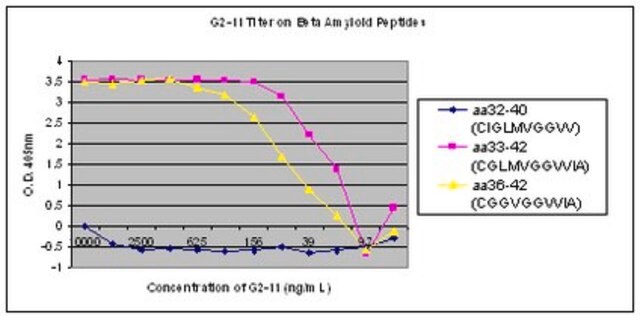ABN1703
Anti-Tau, AEP-cleaved (N368) Antibody
serum, from rabbit
Synonyme(s) :
Microtubule-associated protein tau, AEP-cleaved N368 fragment, Neurofibrillary tangle protein, AEP-cleaved N368 fragment, Paired helical filament-tau, AEP-cleaved N368 fragment, PHF-tau, AEP-cleaved N368 fragment, Tau, AEP-cleaved N368 fragment
About This Item
Produits recommandés
Source biologique
rabbit
Niveau de qualité
Forme d'anticorps
serum
Type de produit anticorps
primary antibodies
Clone
polyclonal
Espèces réactives
human
Réactivité de l'espèce (prédite par homologie)
canine (based on 100% sequence homology), mouse (based on 100% sequence homology), rat (based on 100% sequence homology), monkey (based on 100% sequence homology), bovine (based on 100% sequence homology)
Technique(s)
western blot: suitable
Numéro d'accès NCBI
Numéro d'accès UniProt
Conditions d'expédition
dry ice
Modification post-traductionnelle de la cible
unmodified
Informations sur le gène
dog ... Mapt(480488)
human ... MAPT(4137)
mouse ... Mapt(17762) , Mapt(281296)
rat ... Mapt(29477)
rhesus monkey ... Mapt(574327)
Description générale
Spécificité
Immunogène
Application
Neuroscience
Developmental Signaling
Qualité
Western Blotting Analysis: A 1:100,000 dilution of this antiserum specifically detected 1 µg of purified aa 1-368 Tau fragment, but not the full-length Tau protein.
Description de la cible
Forme physique
Stockage et stabilité
Handling Recommendations: Upon receipt and prior to removing the cap, centrifuge the vial and gently mix the solution. Aliquot into microcentrifuge tubes and store at -20°C. Avoid repeated freeze/thaw cycles, which may damage IgG and affect product performance.
Autres remarques
Clause de non-responsabilité
Not finding the right product?
Try our Outil de sélection de produits.
En option
Code de la classe de stockage
12 - Non Combustible Liquids
Classe de danger pour l'eau (WGK)
WGK 1
Point d'éclair (°F)
Not applicable
Point d'éclair (°C)
Not applicable
Certificats d'analyse (COA)
Recherchez un Certificats d'analyse (COA) en saisissant le numéro de lot du produit. Les numéros de lot figurent sur l'étiquette du produit après les mots "Lot" ou "Batch".
Déjà en possession de ce produit ?
Retrouvez la documentation relative aux produits que vous avez récemment achetés dans la Bibliothèque de documents.
Notre équipe de scientifiques dispose d'une expérience dans tous les secteurs de la recherche, notamment en sciences de la vie, science des matériaux, synthèse chimique, chromatographie, analyse et dans de nombreux autres domaines..
Contacter notre Service technique








